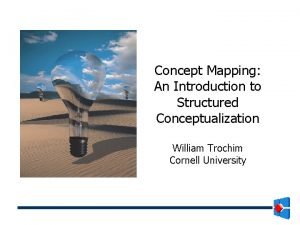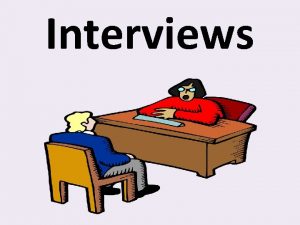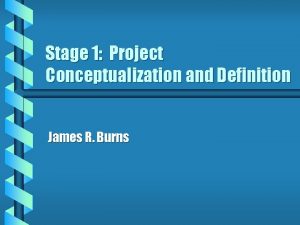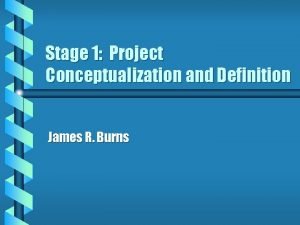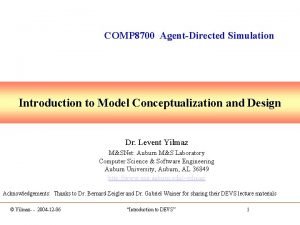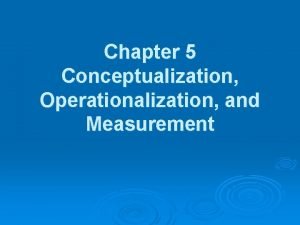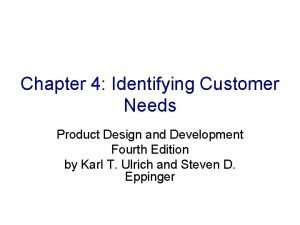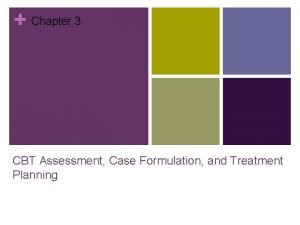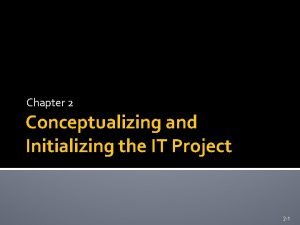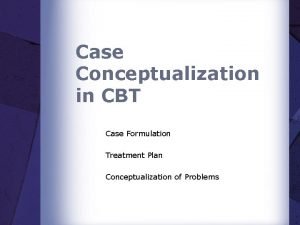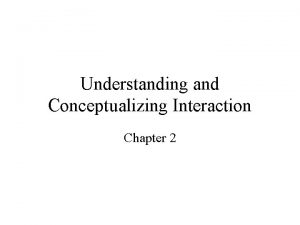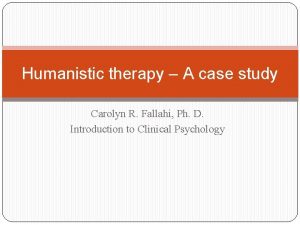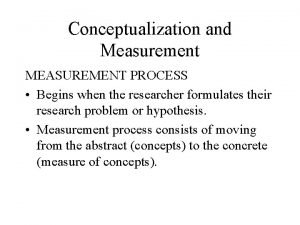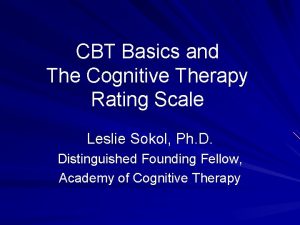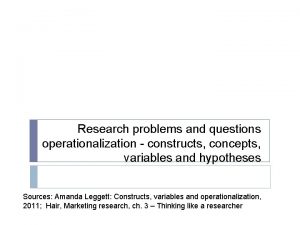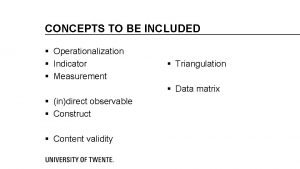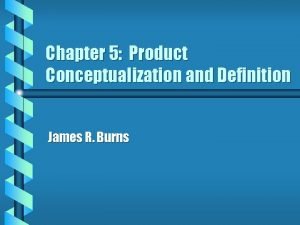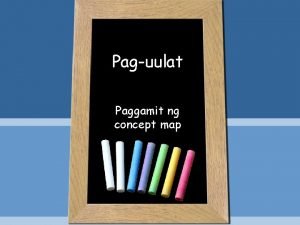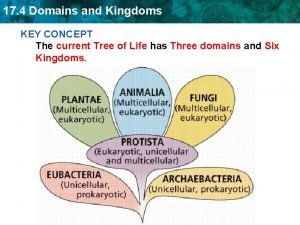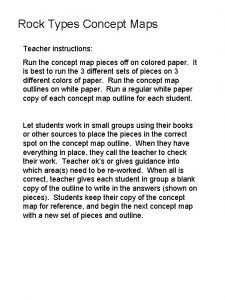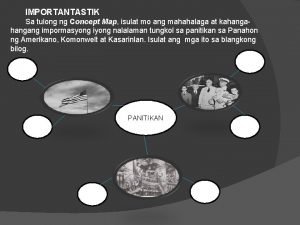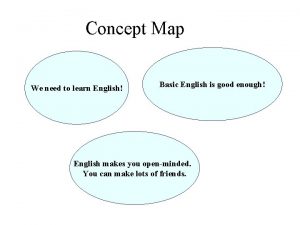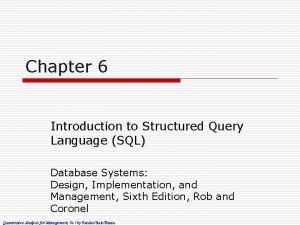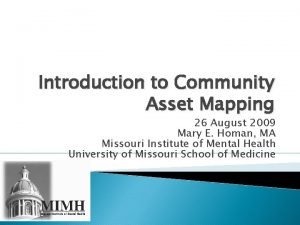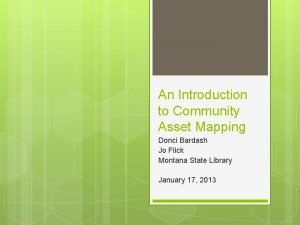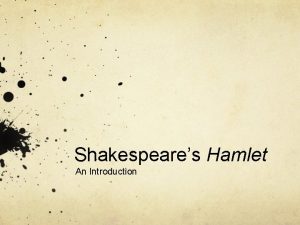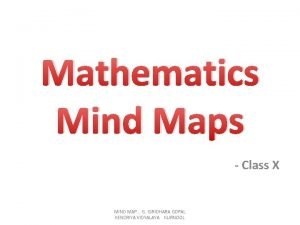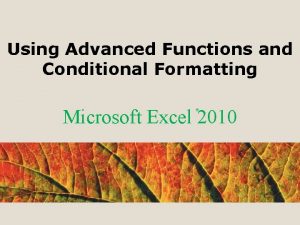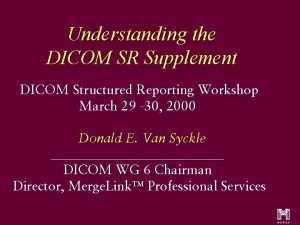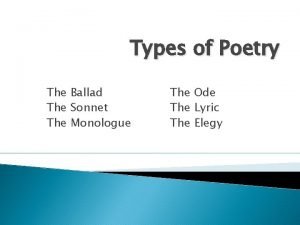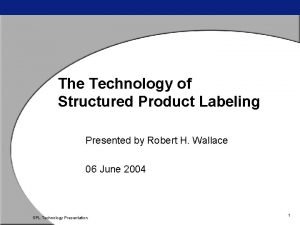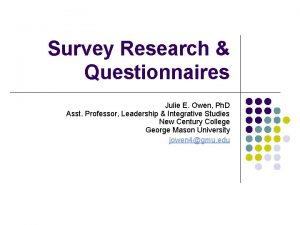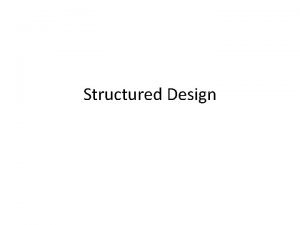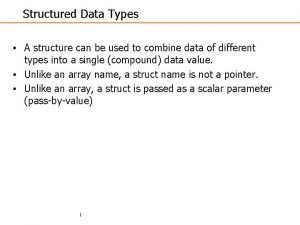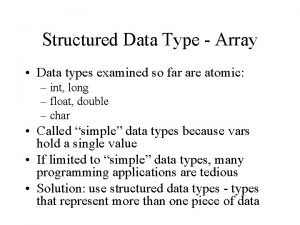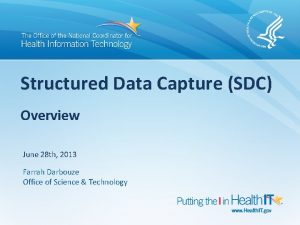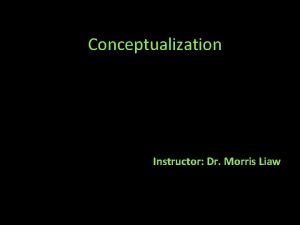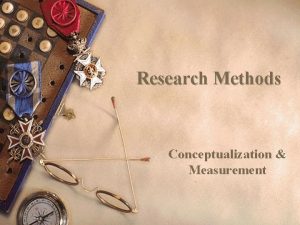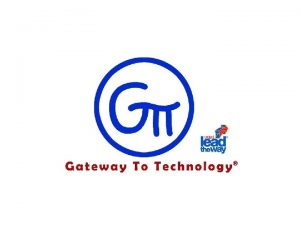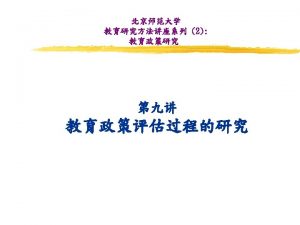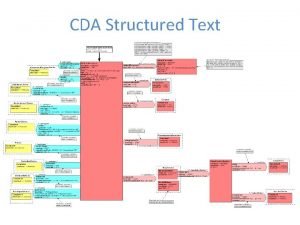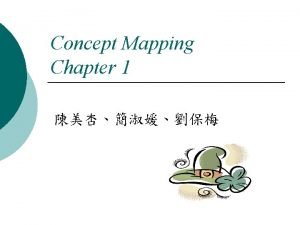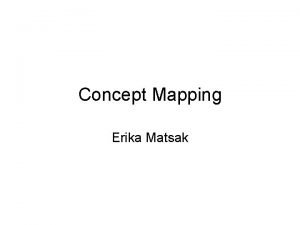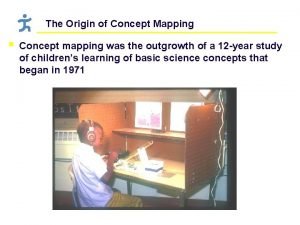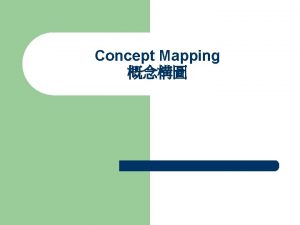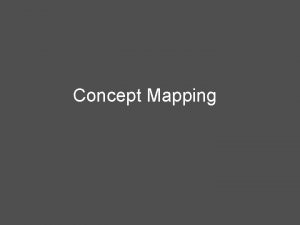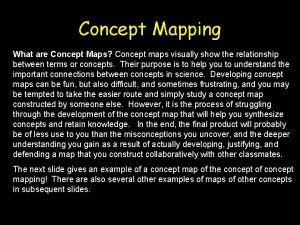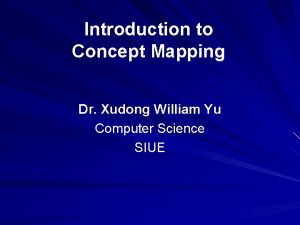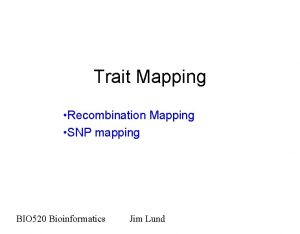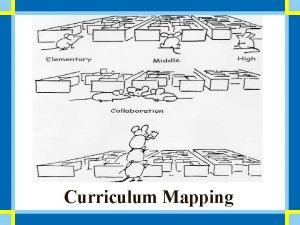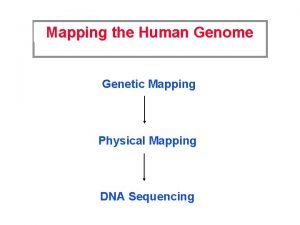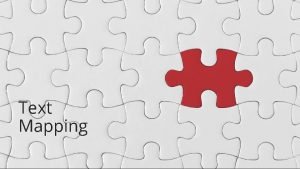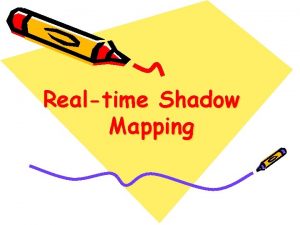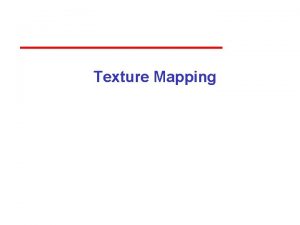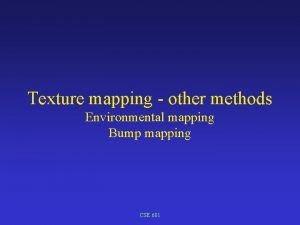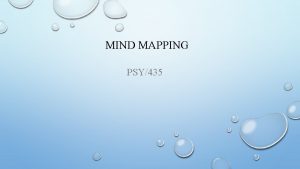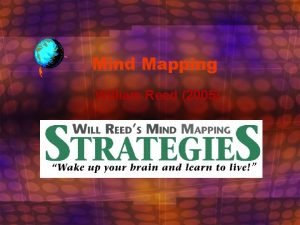Concept Mapping An Introduction to Structured Conceptualization William
































































- Slides: 64

Concept Mapping: An Introduction to Structured Conceptualization William Trochim Cornell University

What is concept mapping? A method that. . . Focuses and helps objectify the group planning process Helps individuals think as a group. . . without losing their individuality Helps groups to manage complexity. . . without trivializing or losing detail

In about 4 hours of participant time a group can. . . Brainstorm a large set of issues. . . • innovations in way network is delivered • (investigate) corporate/structural alignment • assist in the development of non-traditional partnerships (Rehab with the Medicine Community) • expand investigation and knowledge of PSN'S/PSO's • continue STHCS sponsored forums on public health issues (medicine managed care forum) • inventory assets of all participating agencies (providers, Venn Diagrams) • access additional funds for telemedicine expansion • better utilization of current technological bridge • continued support by STHCS to member facilities • expand encourage utilization of interface programs to strengthen the viability and to improve the health care delivery system (ie teleconference) • discussion with CCHN

brainstorm • innovations in way network is delivered • (investigate) corporate/structural alignment • assist in the development of non-traditional partnerships (Rehab with the Medicine Community) • expand investigation and knowledge of PSN'S/ PSO's • continue STHCS sponsored forums on public health issues (medicine sort managed care forum) inventory assets of all participating agencies (providers, Venn Diagrams) access additional funds for telemedicine expansion better utilization of current technological bridge continued support by STHCS to member facilities expand encourage utilization of interface programs to strengthen the viability and to improve the health care delivery system ( ie teleconference) • discussion with CCHN • • • Decide how to manage multiple tasks. 20 Manage resources effectively. 4 Work quickly and effectively under pressure 49 Organize the work when directions are not specific. 39 ng ati 5 1 2 1 rate ime et ag ect eff ly ive . ely ctiv ffe se e urc ic. s. ecif at ask wh t sp of le t no de cide ultip are ltitu d de m u s e 2 4 ion ag a m an an ect an tion 3 5 dir Sc rma tant. to m en 4 wh 3 info por e how rk im o 3 id is ec 5 w D n he ly 2 4 et ive atio 4 niz ect 3 orm t. ga 5 eff inf ortan Or 2 of ime p 4 t e 5 d is im ge 1 3 itu na 5 ult hat Ma 2 4 am ew 1 id an 1 3 5 Sc d dec 2 an 4 3 1 3 5 2 4 1 3 2 1 R . . . organize the issues. . . t ee Sh 1 n Ma o res ge na Ma

brainstorm • innovations in way network is delivered • (investigate) corporate/structural alignment • assist in the development of non-traditional partnerships (Rehab with the Medicine Community) • expand investigation and knowledge of PSN'S/ PSO's • continue STHCS sponsored forums on public health issues (medicine managed care forum) inventory assets of all participating agencies (providers, Venn Diagrams) access additional funds for telemedicine expansion better utilization of current technological bridge continued support by STHCS to member facilities expand encourage utilization of interface programs to strengthen the viability and to improve the health care delivery system ( ie teleconference) • discussion with CCHN • • • …”map” the issues. . . organize sort Decide how to manage multiple tasks. 20 Manage resources effectively. 4 Work quickly and effectively under pressure 49 Organize the work when directions are not specific. 39 g. S tin Ra ly ive et he time effect na ge Ma na Ma 2 5 4 1 3 3 5 2 4 4 1 3 2 4 1 ly. tive ec s eff d rce ou n an res c. atio cifi rm ks. info t. t spe le tas of no de ortan multip s are ltitu imp ge ion na a mu at is ect ma an e wh dir Sc en w to cid wh de e ho rk cid wo De e the niz d ly ga an ive Or on ect ati 5 5 e eff orm tim inf nt. ge of na rta de 5 Ma ltitu impo 4 1 a mu at is an wh Sc cide 5 de 4 3 ge 1 5 4 3 2 1 3 Information Services 5 2 Technology 4 1 3 2 1 rate Community & Consumer Views Regionalization Management Financing STHCS as model

• better utilization of current technological bridge (8) • expand encourage utilization of interface programs to strengthen the viability and to improve the health care delivery system (ie teleconference) (10) • patient information system to be shared by all members (19) • the STHCS will assess the status of all participant organization interface technology development and needs (20) • teleconference board meeting (21) • development of interface technology (30) • continued advancement of tech interface (44) • assure 100% board member access to wide area network (46) • utilize the televideo telecommunication, telemedicine to share resources/strengths (50) • establishment of a virtual network -- as an intranet originally and eventually an internet solution (61) Information Services Technology Community & Consumer Views Regionalization Financing Management STHCS as model

brainstorm • innovations in way network is delivered • (investigate) corporate/structural alignment • assist in the development of non-traditional partnerships (Rehab with the Medicine Community) • expand investigation and knowledge of PSN'S/ PSO's • continue STHCS sponsored forums on public health issues (medicine managed care forum) inventory assets of all participating agencies (providers, Venn Diagrams) access additional funds for telemedicine expansion better utilization of current technological bridge continued support by STHCS to member facilities expand encourage utilization of interface programs to strengthen the viability and to improve the health care delivery system ( ie teleconference) • discussion with CCHN • • • Information Services organize Technology sort Decide how to manage multiple tasks. 20 Community & Consumer Views Manage resources effectively. 4 Work quickly and effectively under pressure 49 Organize the work when directions are not specific. 39 g. S tin Ra ly ive et he time effect na ge Ma na Ma 2 5 4 1 3 3 5 2 4 4 1 3 2 4 1 ly. tive ec s eff d rce ou n an res c. atio cifi rm ks. info t. t spe le tas of no de ortan multip s are ltitu imp ge ion na a mu at is ect ma an e wh dir Sc en w to cid wh de e ho rk cid wo De e the niz d ly ga an ive Or on ect ati 5 5 e eff orm tim inf nt. ge of na rta de 5 Ma ltitu impo 4 1 a mu at is an wh Sc cide 5 de 4 3 ge 1 5 4 3 2 1 3 5 2 4 1 3 2 1 Regionalization rate map Information Services Technology Community & Consumer Views Regionalization Financing Management Mission & Ideology STHCS as model . . . prioritize the issues. . .

brainstorm • innovations in way network is delivered • (investigate) corporate/structural alignment • assist in the development of non-traditional partnerships (Rehab with the Medicine Community) • expand investigation and knowledge of PSN'S/ PSO's • continue STHCS sponsored forums on public health issues (medicine managed care forum) inventory assets of all participating agencies (providers, Venn Diagrams) access additional funds for telemedicine expansion better utilization of current technological bridge continued support by STHCS to member facilities expand encourage utilization of interface programs to strengthen the viability and to improve the health care delivery system ( ie teleconference) • discussion with CCHN Counties 1 & 2 • • • 4. 23 4. 4 Mission & Ideology organize Financing sort Decide how to manage multiple tasks. 20 County 3 Technology Regionalization Manage resources effectively. 4 Work quickly and effectively under pressure 49 Organize the work when directions are not specific. 39 Regionalization Management g tin Ra 1 t ee Sh na ge ly 3 5 4 4 3 2 4 1 3 2 1 3 Information Services ge na Ma 2 5 4 3 2 1 ive ly. ect tive ec s eff d rce ou n an res c. atio cifi rm ks. info t. t spe le tas of no de ortan multip s are ltitu imp ge ion na a mu at is ect ma an e wh dir Sc en w to cid wh de e ho rk cid wo De e the niz d ly ga an ive Or on ect ati 5 5 e eff orm tim inf nt. ge of na rta de 5 Ma ltitu impo 4 1 a mu at is an wh Sc cide 5 de 4 3 e eff tim Ma 5 4 3 2 1 5 2 4 1 3 2 1 Management Community & Consumer Views rate Community & Consumer Views Technology map Information Services 3. 55 Technology r =. 72 3. 56 Community & Consumer Views Regionalization prioritize Information Services Technology Community & Consumer Views Management Financing STHCS as model Regionalization . . . examine consensus. . . Financing Management Mission & Ideology

brainstorm • innovations in way network is delivered • (investigate) corporate/structural alignment • assist in the development of non-traditional partnerships (Rehab with the 5 Medicine Community) • expand investigation and knowledge of PSN'S/ PSO's • continue STHCS sponsored forums on public health issues (medicine • • • managed care forum) inventory assets of all participating agencies (providers, Venn Diagrams) access additional funds for telemedicine expansion better utilization of current technological bridge continued support by STHCS to member facilities expand encourage utilization of interface programs to strengthen the viability and to improve the health care delivery system ( ie teleconference) discussion with CCHN Feasibility organize sort Decide how to manage multiple tasks. 20 Manage resources effectively. 4 76 75 25 Work quickly and effectively under pressure 49 34 Organize the work when directions are not specific. 39 2. 6 g tin Ra 1 2 1 1 t ee Sh ge ive ly na tive ec s eff rce ou Ma ge 22 62 ly. ect e eff tim d n an c. atio cifi rm ks. info t. t spe le tas of no de ortan multip 2 s are ltitu imp ge 4 ion na a mu at is ect ma an e wh dir 3 5 Sc en w to cid wh de 4 e ho 3 rk cid wo 3 De 5 e the 2 niz 4 d ly 4 ga an ive Or on ect 3 ati 5 5 e eff orm 2 tim 4 inf nt. ge of 1 na de porta 3 5 Ma ltitu im 2 4 1 a mu at is 1 an wh 3 Sc cide 5 2 de 4 3 1 3 5 2 4 1 3 5 res na Ma 33 37 10 17 1 45 2 1 1. 8 rate 1. 2 2. 47 map Information Services …and “drill back down” to details for prioritizing action Technology Community & Consumer Views prioritize Regionalization Information Services Technology 4. 23 Community & Consumer Views Management Financing Importance 4. 4 STHCS as model Regionalization 3. 55 Financing Management Mission & Ideology r =. 72 3. 56 4. 8

Concept Mapping Process Concept Mapping (Sorting input) To organize the issues Measurement (Rating input) To observe expectations and results Pattern Matching and Go Zones To link expectations and results, importance and capacity

Concept Mapping to organize Uses information from individuals to: • • identify group shared vision represent group ideas pictorially encourage teamwork facilitate group decision making

To begin… 1. Prepare Project: Develop a focus “A specific issue that is relevant to the mental health of women and girls is. . . " . . . focus

Participants Contribute Knowledge and Opinion 1. Prepare Project • Body image issues- (breast size, hair color/texture, nose, other physical features vs external valuation of "beauty"). (9) • The development and evaluation of Internetbased interventions that can be accessed by women anywhere, anytime. (31) • The impact of race, ethnicity, culture, class, sexual orientation and age on the expression of symptoms. (54) • Lack of encouragement and opportunity at the elementary, middle and high school levels for career opportunities that girls can aspire to. (61) • Lack of parity for mental health care coverage. (102) 2. Generate Ideas

Participants Build the Conceptual Framework 1. Prepare Project sort Decide how to manage multiple tasks. 20 Organize the work when directions are not specific. 39 Manage resources effectively. 4 Work quickly and effectively under 2. Generate Ideas 1 ly ely tive ly. t et. ee he t effective effecivelyctivelyffective. ee tim ffecet ffe s e tively Shng Shetim g e e i s c e g c tin at Sget na e rce elyur ffe. Ra Ratin. Mgahnea e. Manageretimseoffuegcetivresources ectivelyf at what sks. tasks. e e na t oh o fe ta le R 1 g S 1 Maanagtim a res es eof dee w cide halet ultip naostksr. e no et sa ge M nage ltuitrucde udlteitcuid dodf e meuwltip m arle 5 atin 5 1 M t n na ne m uo no ge nsltip 4 R 4 5 2 Ma m es and nuad gceid na ctios. re u e sk a ar cann a tuioltit. adndae mhaatectio 3 5 2 caagne S tnf w ir e mdir ta ns tio t. ma anam 4 5 1 S toe o cidtoeenadnagheltnipleectio e not an rma fnaonram 4 w wouiordtn ow 3 4 5 5 3 M in 3 fo Spcoinart im hltoapitt idnaednhtd. rek wtoh morke meun dir ns ar u m 3 r e 5 is im caidfisom eocart woow e wag wh 2 3 4 4 5 2 tio 3 Daenin io n 2 t Dpnhet. eizhe thma ork direcely tively tion ation 4 1 2 3 im 3 4 5 o w 5 4 Sc o 4 rmisaizeteatcnid 1 3 r rgaonwict. the when fectiv effec elyorma fto. rm aionnt. 1 2 5 inf rganpo. DO 2 3 4 4 53 f. e h cizife rk inn f rtt 1 2 Ois 4 imcifcic en wo ime e time fecotiv id 4 1 2 3 f in eoorfta orpmoa nt. p a 5 3 e 5 s 4 f rnta 1 5 5 sp. De Org tifhice. e t age e eufdeelyltituimdp t fisinim 3 1 2 o 2 3 4 ut is heao m 4 54 5 5 nspizeec anag Man e tim aptio lteitctiv a m u 1 im 2 w d r h t a M g 4 f 1 2 3 a u mf o n. g. 3 4 5 O 5 r 1 cific 1 Manan a e ecidaen w ecuidltite hf aintfis orta 1 3 a im o 1 2 m 2 3 4 54 5 spe 5 1 Sgce t de. Sc dad dee w imp 1 2 4 1 2 3 na a 3 nd Scaann udlteitcuid at is 5 3 4 a 3 5 1 M m d 3 wh 1 2 2 3 4 51 3 an aan cide 1 2 3 4 Sc d de 3 4 5 5 1 3 1 2 an 2 3 4 1 2 3 5 3 1 1 2 4 2 1 3 1 2 rate 3. Structure Ideas

The Process Turns Knowledge into Data 1. Prepare Project Technology Community & Consumer Views Financing Informatio n Services Regionalization Management Mission & Ideology Area 1 Area 2 4. 22 Mission & Ideology Financing Regionalization Technology Management Regionalization Information Services Community & Consumer Technology 3. 47 2. Generate Ideas 4. 4 Mission & Ideology Management r =. 51 Community & Consumer 3. 56 3. Structure Ideas 4. Compute Maps

And Data Into Meaning 1. Prepare Project Technical Issues Processes/ Methodology Graphical User Interface Documentation Client Issues Change Control Personal Awareness & Skill Team Issues Management 2. Generate Ideas 5. Interpret Maps 3. Structure Ideas 4. Compute Maps

Meaning Into Action, Policy, and Evaluation 1. Prepare Project 6. Utilize Maps Area 1 Area 2 4. 22 4. 4 Mission & Ideology Financing Regionalization Technology Management Regionalization Information Services Community & Consumer Views Management Technology 3. 47 5. Interpret Maps 2. Generate Ideas Community & Consumer Views r =. 51 3. 56 3. Structure Ideas 4. Compute Maps

The emerging structure… Workforce Transportation Special Needs & Mental Health Housing Continuum Capacity of Community Services Caregiving Access to Benefits Impairments Attitudes Towards Aging Gerotechnology Communication Economic Security Engaged Lifestyle …contains all the details and provides a conceptual framework.

How Did We Build These Results? • The Raw Materials: – Statements – Sort Input from each participant • The Tools – – – Aggregation of Sort Data Similarity Matrix Multidimensional Scaling Hierarchical cluster analysis Anchoring/Bridging Analysis

Representation Sort for one participant Binary, square similarity matrix Total square similarity matrix across participants

Multidimensional Scaling 5 1 2 4 0 1 1 3 1 0 1 5 0 0 0 1 0 0 2 0 5 3 0 0 0 4 0 3 5 0 0 0 0 0 5 0 0 2 0 0 1 1 0 0 0 5 0 0 4 0 1 0 0 0 5 0 0 0 3 0 0 0 2 0 0 5 0 0 1 2 0 0 0 4 0 0 5 0 0 0 0 0 5 Input: A square matrix of relationships among a set of entities 13 3 17 16 22 43 24 23 12 50 25 18 38 26 52 8 44 6 36 37 27 41 29 30 34 7 35 51 47 31 42 10 Output: An n-dimensional mapping of the entities 54 45 28 33 32 14 39 4 1 40 49 20 55 48 46 56 19 53 15 21 11 5 9

Multidimensional Scaling Similarity Matrix 1 2 3 1 5 1 2 2 1 5 0 If 4 out of 5 people grouped statement 1 with 2 3 2 0 5 If 3 out of 5 people grouped statement 1 with 2 If 2 out of 5 people grouped statement 1 with 2 1 If 1 out of 5 people grouped statement 1 with 2 If 0 out of 5 people grouped statement 1 with 2

Multidimensional Scaling Similarity Matrix 1 2 3 1 5 1 2 2 1 5 0 3 2 0 5 2 1

Multidimensional Scaling Similarity Matrix 1 2 3 1 5 1 2 2 1 5 0 3 2 0 5 3 2 1 3

Multidimensional Scaling Similarity Matrix 1 2 3 4 1 5 1 2 4 2 1 5 0 0 3 2 0 5 3 4 4 0 3 5 3 2 4 1

Multidimensional Scaling Similarity Matrix 1 2 3 4 1 5 1 2 4 2 1 5 0 0 3 2 0 5 3 4 4 0 3 5 y 3 A map can be depicted as a coordinate matrix 1 2 3 4 Coordinate Matrix x y 2. 8 1. 0 5. 9 3. 2 1. 1 3. 2 1. 9 1. 3 2 4 1 x

Multidimensional Scaling Similarity Matrix 1 2 3 4 1 5 1 2 4 2 1 5 0 0 3 2 0 5 3 4 4 0 3 5 y 3 A map can be depicted as a coordinate matrix 1 2 3 4 Coordinate Matrix x y 2. 8 1. 0 5. 9 3. 2 1. 1 3. 2 1. 9 1. 3 2 c 4 1 b a x And from the coordinates we can compute the distances between all pairs of points a 2 + b 2 = c 2 a = difference between x values b = difference between y values c = distance

Multidimensional Scaling Distance Matrix Similarity Matrix 1 2 3 4 1 5 1 2 4 2 1 5 0 0 3 2 0 5 3 4 4 0 3 5 1 2 3 4 y 3 A map can be depicted as a coordinate matrix 1 2 3 4 Coordinate Matrix x y 2. 8 1. 0 5. 9 3. 2 1. 1 3. 2 1. 9 1. 3 1 0. 0 3. 2 2. 8 1. 1 2 3. 2 0. 0 4. 8 4. 6 3 2. 8 4. 8 0. 0 2. 1 4 1. 1 4. 6 2. 1 0. 0 2 4 1 And can show these as a matrix of distances between points x And from the coordinates we can compute the distances between all pairs of points a 2 + b 2 = c 2 a = difference between x values b = difference between y values c = distance

Multidimensional Scaling Stress Similarity Matrix 1 2 3 4 1 5 1 2 4 2 1 5 0 0 3 2 0 5 3 4 4 0 3 5 y 3 A map can be depicted as a coordinate matrix 1 2 3 4 Coordinate Matrix x y 2. 8 1. 0 5. 9 3. 2 1. 1 3. 2 1. 9 1. 3 Distance Matrix Is the relationship between the similarity input matrix and the distances on the map 1 2 3 4 1 0. 0 3. 2 2. 8 1. 1 2 3. 2 0. 0 4. 8 4. 6 3 2. 8 4. 8 0. 0 2. 1 4 1. 1 4. 6 2. 1 0. 0 2 4 1 And can show these as a matrix of distances between points x And from the coordinates we can compute the distances between all pairs of points a 2 + b 2 = c 2 a = difference between x values b = difference between y values c = distance

Multidimensional Scaling Stress Similarity Matrix 1 2 3 4 1 5 1 2 4 2 1 5 0 0 3 2 0 5 3 4 4 0 3 5 Is the relationship between the similarity input matrix and the distances on the map Similarities 1, 1 1, 2 1, 3 1, 4 2, 2 2, 3 2, 4 3, 3 3, 4 4, 4 5 1 2 4 5 0 0 5 3 5 Distance Matrix 1 2 3 4 1 0. 0 3. 2 2. 8 1. 1 Distances Low stress values means there is a greater correspondence between the similarities and the map 1, 1 1, 2 1, 3 1, 4 2, 2 2, 3 2, 4 3, 3 3, 4 4, 4 0. 0 3. 2 2. 8 1. 1 0. 0 4. 8 4. 6 0. 0 2. 1 0. 0 2 3. 2 0. 0 4. 8 4. 6 3 2. 8 4. 8 0. 0 2. 1 4 1. 1 4. 6 2. 1 0. 0

Multidimensional Scaling • Directionality – Does MDS know North from South? • Dimensionality – Why only two dimensions? • Stress – How much does it really matter?

Cluster Analysis • Hierarchical – clusters get built in a tree-like method • Agglomerative – builds toward all items in one pile (divisive - all start in one and divide) • Clustering criterion – the rule used to decide the next cluster merge – Ward’s algorithm • Number of Clusters

Cluster Analysis 7 5 8 1 9 10 6 2 3 4 Merge Points Merged Number of Clusters 1 1 10 9 8 7 6 5 4 3 2 1 6 8 3 4 7 5 9 10 2

Cluster Analysis 7 5 8 1 9 10 6 2 3 4 Merge Points Merged 1+6 Number of Clusters 1 1 10 9 8 7 6 5 4 3 2 1 6 8 3 4 7 5 9 10 2

Cluster Analysis 7 5 8 1 9 10 6 2 3 4 Merge Points Merged 1+6 5+7 Number of Clusters 1 2 1 10 9 8 7 6 5 4 3 2 1 6 8 3 4 7 5 9 10 2

Cluster Analysis 7 5 8 1 9 10 6 2 3 4 Merge Points Merged 1+6 5+7 9 + 10 Number of Clusters 1 2 3 1 10 9 8 7 6 5 4 3 2 1 6 8 3 4 7 5 9 10 2

Cluster Analysis 7 5 8 1 9 10 6 2 3 4 Merge Points Merged 1+6 5+7 9 + 10 (1 + 6) + 8 Number of Clusters 1 2 3 4 1 10 9 8 7 6 5 4 3 2 1 6 8 3 4 7 5 9 10 2

Cluster Analysis 7 5 8 1 9 10 6 2 3 4 Merge Points Merged 1+6 5+7 9 + 10 (1 + 6) + 8 3+4 Number of Clusters 1 2 3 4 5 1 10 9 8 7 6 5 4 3 2 1 6 8 3 4 7 5 9 10 2

Cluster Analysis 7 5 8 1 9 10 6 2 3 4 Merge Points Merged 1+6 5+7 9 + 10 (1 + 6) + 8 3+4 2 + (9 + 10) Number of Clusters 1 2 3 4 5 6 1 10 9 8 7 6 5 4 3 2 1 6 8 3 4 7 5 9 10 2

Cluster Analysis 7 5 8 1 9 10 6 2 3 4 Merge Points Merged 1+6 5+7 9 + 10 (1 + 6) + 8 3+4 2 + (9 + 10) ((1 + 6) + 8)) + (3 + 4) Number of Clusters 1 2 3 4 5 6 7 1 10 9 8 7 6 5 4 3 2 1 6 8 3 4 7 5 9 10 2

Cluster Analysis 7 5 8 1 9 10 6 2 3 4 Merge Points Merged 1+6 5+7 9 + 10 (1 + 6) + 8 3+4 2 + (9 + 10) ((1 + 6) + 8)) + (3 + 4) (5 + 7) + ((2 + (9 + 10)) Number of Clusters 1 2 3 4 5 6 7 8 1 10 9 8 7 6 5 4 3 2 1 6 8 3 4 7 5 9 10 2

Cluster Analysis 7 5 8 1 9 10 6 2 3 4 Merge Points Merged 1+6 5+7 9 + 10 (1 + 6) + 8 3+4 2 + (9 + 10) ((1 + 6) + 8)) + (3 + 4) (5 + 7) + ((2 + (9 + 10)) (((1 + 6) + 8)) + (3 + 4)) + (5 + 7) + ((2 + (9 + 10)) Number of Clusters 1 2 3 4 5 6 7 8 9 1 10 9 8 7 6 5 4 3 2 1 6 8 3 4 7 5 9 10 2

What is the Bridging Value? tells you whether the statement was sorted with others that are close to it on the map or whether it was sorted with items that are farther away on the map.

The Bridging Value • Helps us interpret what content is associated with specific areas of the map • Statements with lower bridging values are generally better indicators of the meaning of their part of the map than statements with higher bridging values • Statements with higher bridging values means statement is a bridge between different areas on map

Compute Bridging Values • A bridging value always ranges from 0 to 1 • The bridging values are computed after the map is computed. • The cluster bridging value is simply the average bridging value across all statements in a cluster.

Bridging Value, Step 1 1. We begin by computing the proportion of sorters who put point i and j together in a pile: where sij = number of sorters who placed point i and j together in the same pile m = total number of sorters pij = proportion of sorters who placed point i and j together in the same pile

Bridging Value, Step 2 2. We compute the Euclidean Distance between all pairs of standardized points: Where xi = MDS x-coordinate for point i yi = MDS y-coordinate for point i xj = MDS x-coordinate for point j yj = MDS y-coordinate for point j dij = standardized Euclidean Distance between points i and j

Bridging Value, Step 3 3. We compute the unstandardized bridging value: where bi = bridging raw value for point i pij = proportion of sorters who placed point i and j together in the same pile dij = standardized Euclidean Distance between points i and j

Bridging Value, Step 4 4. Normalize the bridging raw value: Where bi min(b) max(b) bi = = bridging raw value for point i minimum of the bi values maximum of the bi values standardized bridging value

Sort Pile Label Analysis • finds the “best fitting” sort pile label for a cluster • done after the map is computed • based on centroid computations

Sort Pile Label Analysis What is a centroid? 3 43 Y 50 36 41 37 X

Sort Pile Label Analysis What is a centroid? 3 43 Y 50 36 41 37 X

Sort Pile Label Analysis What is a centroid? Average Y 3 43 50 36 X 41 37 Average X

Sort Pile Label Analysis 13 3 2 16 43 22 50 x 36 37 Cluster Centroid 29 distance Pile Centroid 50, 36, 43, 3, 16, 29 27 18 38 26 52 8 44 6 30 34 7 35 51 47 31 42 10 54 Your Pile: 12 25 x 41 24 23 17 45 28 32 14 39 4 33 1 40 49 20 48 19 55 53 15 21 46 11 56 5 9

Sort Pile Label Analysis • Every cluster has a centroid • Every sort pile has a centroid – the average x, y for all items in the pile – this is the best location on the map for the pile label – can compute the distance between this label and any other point on the map • For each cluster – compare distance between its centroid and each sort pile centroid – best sort pile label is the closest one

Cluster Map with Labels Workforce Transportation Special Needs & Mental Health Housing Continuum Capacity of Community Services Caregiving Access to Benefits Impairments Gerotechnology Economic Security Communication Attitudes Towards Aging Engaged Lifestyle

Importance Housing Continuum Workforce Capacity of Community Services Transportation Caregiving Access to Benefits Special Needs & Mental Health Impairments Communication Gerotechnology Attitudes Towards Aging Layer Value 1 3. 62 to 3. 79 2 3. 79 to 3. 95 3 3. 95 to 4. 12 4 4. 12 to 4. 29 5 4. 29 to 4. 46 Engaged Lifestyle Economic Security

Feasibility Housing Continuum Workforce Transportation Caregiving Capacity of Community Services Special Needs & Mental Health Access to Benefits Communication Gerotechnology Impairments Attitudes Towards Aging Layer Value 1 2. 98 to 3. 11 2 3. 11 to 3. 23 3 3. 23 to 3. 35 4 3. 35 to 3. 47 5 3. 47 to 3. 59 Economic Security Engaged Lifestyle

Importance 4. 46 Economic Security Housing Continuum Workforce Access to Benefits Transportation Workforce Capacity of Community Services Impairments Caregiving Communication Housing Continuum Special Needs & Mental Health Attitudes Towards Aging Gerotechnology Engaged Lifestyle 3. 62 Capacity of Community Services Transportation Caregiving Access to Benefits Special Needs & Mental Health Communication Gerotechnology Impairments Attitudes Towards Aging Layer Value 1 3. 62 to 3. 79 2 3. 79 to 3. 95 3 3. 95 to 4. 12 4 4. 12 to 4. 29 5 4. 29 to 4. 46 Engaged Lifestyle Economic Security

Feasibility 3. 59 Communication Housing Continuum Workforce Transportation Caregiving Capacity of Community Services Special Needs & Mental Health Access to Benefits Communication Gerotechnology Impairments Attitudes Towards Aging Layer Value 1 2. 98 to 3. 11 2 3. 11 to 3. 23 3 3. 23 to 3. 35 4 3. 35 to 3. 47 5 3. 47 to 3. 59 Economic Security Engaged Lifestyle Transportation Engaged Lifestyle Impairments Special Needs & Mental Health Capacity of Community Services Attitudes Towards Aging Gerotechnology Workforce Caregiving Housing Continuum Access to Benefits Economic Security 2. 98

Importance vs. Feasibility Importance Feasibility 4. 46 3. 59 Economic Security Communication Access to Benefits Transportation Workforce Capacity of Community Services Impairments Caregiving Communication Housing Continuum Special Needs & Mental Health Transportation Engaged Lifestyle Impairments Special Needs & Mental Health Capacity of Community Services Attitudes Towards Aging Gerotechnology Workforce Attitudes Towards Aging Caregiving Housing Continuum Access to Benefits Economic Security Gerotechnology Engaged Lifestyle 3. 62 r = -. 27 2. 98

Comparing each Unique Statement on Importance and Feasibility: Go Zones High the number of senior community centers in outer boroughs and their ability to handle influx (1) Feasibility 1 3 2 research funding for Alzheimer's (4) 4 Low Importance High affordable opportunities for recreation / entertainment/ socialization for seniors, including access to fitness and wellness programs (3) homecare services during holidays and vacations (2) Cluster mean of each scale is used to divide the matrix

Features of Concept Mapping • guides project throughout life-cycle beginning to end • involves many stakeholder groups throughout the entire training life-cycle • easily scalable and transferable • uses state-of-the-art analytical tools to provide rigor and credibility

Benefits of Concept Mapping • visual product is easy to understand present • identifies disconnects before significant investments are made • offers significant cost savings while improving the quality of project
 Structured conceptualization
Structured conceptualization Unstructured interview
Unstructured interview How can we integrate oop with sd/sa
How can we integrate oop with sd/sa Memory parameters
Memory parameters Forward mapping vs backward mapping
Forward mapping vs backward mapping Transform mapping dan transaction mapping
Transform mapping dan transaction mapping Structured analysis tools in system analysis and design
Structured analysis tools in system analysis and design Project conceptualization
Project conceptualization Conceptualization stage
Conceptualization stage Model conceptualization in simulation
Model conceptualization in simulation Conceptualization definition in research
Conceptualization definition in research Customer needs identification process
Customer needs identification process Formative influence cbt
Formative influence cbt Intensions
Intensions Cbt case conceptualization and treatment planning example
Cbt case conceptualization and treatment planning example Conceptualizing interaction
Conceptualizing interaction Humanistic therapy examples
Humanistic therapy examples The measurement process begins with
The measurement process begins with Cognitive conceptualization diagram
Cognitive conceptualization diagram Operational definition in research example
Operational definition in research example Operationalizing dependent variables
Operationalizing dependent variables Conceptualization def
Conceptualization def Product conceptualization
Product conceptualization Concept map ng pananaliksik
Concept map ng pananaliksik Mitosis and meiosis concept map
Mitosis and meiosis concept map Concept mapping chapter 11 genetic disorders
Concept mapping chapter 11 genetic disorders Chapter 34 circulation in humans concept mapping answer key
Chapter 34 circulation in humans concept mapping answer key Chapter 28 section 1: fishes study guide answer key
Chapter 28 section 1: fishes study guide answer key Amphibia characteristics
Amphibia characteristics Concept mapping chapter 28 fishes and amphibians
Concept mapping chapter 28 fishes and amphibians 4 kingdoms of life
4 kingdoms of life Concept mapping of the different rock types
Concept mapping of the different rock types Igneous rock concept map
Igneous rock concept map Semantic map ng salitang lipunan
Semantic map ng salitang lipunan Concept mapping tutorial
Concept mapping tutorial Chapter 34 section 2 the respiratory system
Chapter 34 section 2 the respiratory system Crossing over occurs during
Crossing over occurs during Concept mapping in english grammar
Concept mapping in english grammar Concept mapping chapter 10 meiosis 1 and meiosis 2
Concept mapping chapter 10 meiosis 1 and meiosis 2 Introduction to structured query language (sql)
Introduction to structured query language (sql) Introduction to structured query language (sql)
Introduction to structured query language (sql) An introduction to community asset mapping
An introduction to community asset mapping Community asset mapping examples
Community asset mapping examples Real self vs ideal self adalah
Real self vs ideal self adalah Perbedaan selling concept dan marketing concept
Perbedaan selling concept dan marketing concept Introduction of hamlet
Introduction of hamlet Lotf timeline
Lotf timeline Introduction of macbeth by william shakespeare
Introduction of macbeth by william shakespeare Modern concept in child health care
Modern concept in child health care Modern concept of pediatric nursing
Modern concept of pediatric nursing Concept map of some applications of trigonometry class 10
Concept map of some applications of trigonometry class 10 My structured query language
My structured query language What is an unqualified structured reference in excel
What is an unqualified structured reference in excel Dicom structured report
Dicom structured report Structured poem examples
Structured poem examples It is a dignified and elaborately structured lyric poem
It is a dignified and elaborately structured lyric poem Structured product labeling
Structured product labeling What is an example of a semi-structured interview?
What is an example of a semi-structured interview? What is a structured questionnaire
What is a structured questionnaire Structured design example
Structured design example Structured data types
Structured data types Structured text array initialization
Structured text array initialization Structured data capture
Structured data capture Structured system analysis and design method
Structured system analysis and design method System requirements document
System requirements document
